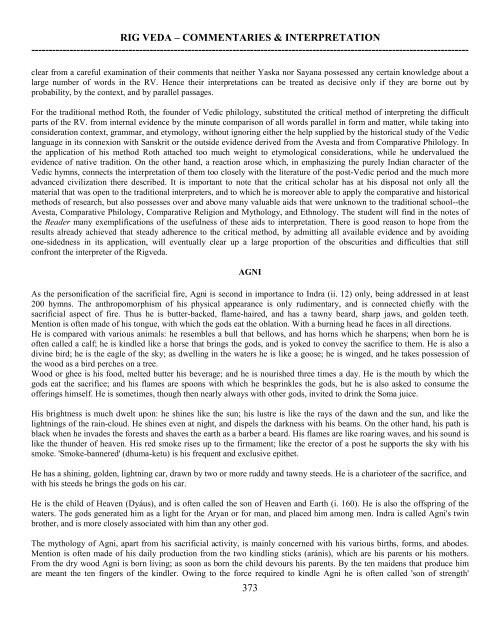You also want an ePaper? Increase the reach of your titles
YUMPU automatically turns print PDFs into web optimized ePapers that Google loves.
RIG VEDA – COMMENTARIES & INTERPRETATION<br />
------------------------------------------------------------------------------------------------------------------------------<br />
clear from a careful examination of their comments that neither Yaska nor Sayana possessed any certain knowledge about a<br />
large number of words in the RV. Hence their interpretations can be treated as decisive only if they are borne out by<br />
probability, by the context, and by parallel passages.<br />
For the traditional method Roth, the founder of Vedic philology, substituted the critical method of interpreting the difficult<br />
parts of the RV. from internal evidence by the minute comparison of all words parallel in form and matter, while taking into<br />
consideration context, grammar, and etymology, without ignoring either the help supplied by the historical study of the Vedic<br />
language in its connexion with Sanskrit or the outside evidence derived from the Avesta and from Comparative Philology. In<br />
the application of his method Roth attached too much weight to etymological considerations, while he undervalued the<br />
evidence of native tradition. On the other hand, a reaction arose which, in emphasizing the purely Indian character of the<br />
Vedic hymns, connects the interpretation of them too closely with the literature of the post-Vedic period and the much more<br />
advanced civilization there described. It is important to note that the critical scholar has at his disposal not only all the<br />
material that was open to the traditional interpreters, and to which he is moreover able to apply the comparative and historical<br />
methods of research, but also possesses over and above many valuable aids that were unknown to the traditional school--the<br />
Avesta, Comparative Philology, Comparative Religion and Mythology, and Ethnology. The student will find in the notes of<br />
the Reader many exemplifications of the usefulness of these aids to interpretation. There is good reason to hope from the<br />
results already achieved that steady adherence to the critical method, by admitting all available evidence and by avoiding<br />
one-sidedness in its application, will eventually clear up a large proportion of the obscurities and difficulties that still<br />
confront the interpreter of the <strong>Rig</strong>veda.<br />
AGNI<br />
As the personification of the sacrificial fire, Agni is second in importance to Indra (ii. 12) only, being addressed in at least<br />
200 hymns. The anthropomorphism of his physical appearance is only rudimentary, and is connected chiefly with the<br />
sacrificial aspect of fire. Thus he is butter-backed, flame-haired, and has a tawny beard, sharp jaws, and golden teeth.<br />
Mention is often made of his tongue, with which the gods eat the oblation. With a burning head he faces in all directions.<br />
He is compared with various animals: he resembles a bull that bellows, and has horns which he sharpens; when born he is<br />
often called a calf; he is kindled like a horse that brings the gods, and is yoked to convey the sacrifice to them. He is also a<br />
divine bird; he is the eagle of the sky; as dwelling in the waters he is like a goose; he is winged, and he takes possession of<br />
the wood as a bird perches on a tree.<br />
Wood or ghee is his food, melted butter his beverage; and he is nourished three times a day. He is the mouth by which the<br />
gods eat the sacrifice; and his flames are spoons with which he besprinkles the gods, but he is also asked to consume the<br />
offerings himself. He is sometimes, though then nearly always with other gods, invited to drink the Soma juice.<br />
His brightness is much dwelt upon: he shines like the sun; his lustre is like the rays of the dawn and the sun, and like the<br />
lightnings of the rain-cloud. He shines even at night, and dispels the darkness with his beams. On the other hand, his path is<br />
black when he invades the forests and shaves the earth as a barber a beard. His flames are like roaring waves, and his sound is<br />
like the thunder of heaven. His red smoke rises up to the firmament; like the erector of a post he supports the sky with his<br />
smoke. 'Smoke-bannered' (dhuma-ketu) is his frequent and exclusive epithet.<br />
He has a shining, golden, lightning car, drawn by two or more ruddy and tawny steeds. He is a charioteer of the sacrifice, and<br />
with his steeds he brings the gods on his car.<br />
He is the child of Heaven (Dyáus), and is often called the son of Heaven and Earth (i. 160). He is also the offspring of the<br />
waters. The gods generated him as a light for the Aryan or for man, and placed him among men. Indra is called Agni's twin<br />
brother, and is more closely associated with him than any other god.<br />
The mythology of Agni, apart from his sacrificial activity, is mainly concerned with his various births, forms, and abodes.<br />
Mention is often made of his daily production from the two kindling sticks (aránis), which are his parents or his mothers.<br />
From the dry wood Agni is born living; as soon as born the child devours his parents. By the ten maidens that produce him<br />
are meant the ten fingers of the kindler. Owing to the force required to kindle Agni he is often called 'son of strength'<br />
373


















